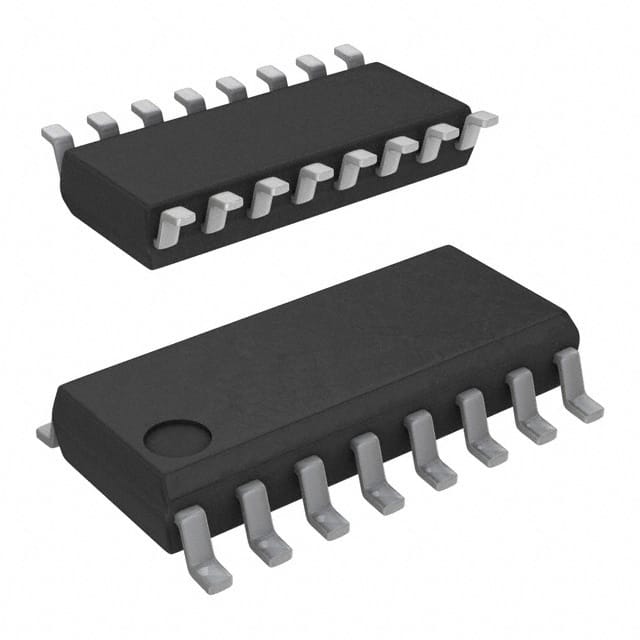CD74HC4046AMT
Overview
Category
CD74HC4046AMT belongs to the category of integrated circuits (ICs).
Use
It is commonly used in electronic devices for frequency synthesis and phase-locked loop (PLL) applications.
Characteristics
- High-speed operation
- Low power consumption
- Wide operating voltage range
- Small package size
Package
CD74HC4046AMT is available in a small outline integrated circuit (SOIC) package.
Essence
The essence of CD74HC4046AMT lies in its ability to generate stable and accurate frequencies for various applications.
Packaging/Quantity
It is typically packaged in reels or tubes, with a quantity of 250 units per reel/tube.
Specifications and Parameters
CD74HC4046AMT has the following specifications and parameters:
- Supply Voltage: 2V to 6V
- Operating Temperature Range: -40°C to +85°C
- Input Frequency Range: DC to 10MHz
- Output Frequency Range: DC to 10MHz
- Phase Detector Frequency Range: DC to 10MHz
- Lock Range: ±5% of VCO Center Frequency
Pin Configuration
The pin configuration of CD74HC4046AMT is as follows:
- Phase Comparator 1 Input
- Phase Comparator 1 Ground
- Phase Comparator 1 Output
- Phase Comparator 2 Input
- Phase Comparator 2 Ground
- Phase Comparator 2 Output
- Voltage-Controlled Oscillator (VCO) Control Voltage
- VCO Ground
- VCO Output
- VCO Power Supply
- VCO Ground
- VCO Input
- VCO Ground
- VCO Input
Functional Characteristics
CD74HC4046AMT offers the following functional characteristics:
- Two phase comparators with a common signal input
- Voltage-controlled oscillator (VCO) with control voltage input
- VCO output frequency proportional to control voltage
- Lock detection circuitry
Advantages and Disadvantages
Advantages
- High-speed operation enables quick frequency synthesis
- Low power consumption for energy-efficient designs
- Wide operating voltage range allows for versatile applications
- Small package size saves board space
Disadvantages
- Limited lock range may restrict certain frequency synthesis requirements
- Input and output frequency range limited to 10MHz
Applicable Range of Products
CD74HC4046AMT is suitable for various electronic devices that require frequency synthesis and phase-locked loop functionality. It finds applications in telecommunications, audio equipment, and digital systems.
Working Principles
The working principle of CD74HC4046AMT involves comparing the phase and frequency of an input signal with a reference signal. The phase comparator generates an error signal, which is used to control the VCO's output frequency. The lock detection circuitry ensures stable operation within the specified lock range.
Detailed Application Field Plans
CD74HC4046AMT can be applied in the following fields:
- Telecommunications: Used in frequency synthesizers for wireless communication systems.
- Audio Equipment: Employed in phase-locked loop circuits for audio signal processing.
- Digital Systems: Integrated into clock generation circuits for microcontrollers and digital logic circuits.
Detailed Alternative Models
Some alternative models to CD74HC4046AMT include:
- CD4046B
- MC14046B
- HEF4046B
- HCF4046B
- TC74HC4046AF
5 Common Technical Questions and Answers
Q: What is the maximum operating voltage for CD74HC4046AMT? A: The maximum operating voltage is 6V.
Q: Can CD74HC4046AMT be used in high-temperature environments? A: Yes, it can operate within a temperature range of -40°C to +85°C.
Q: What is the purpose of the lock detection circuitry? A: The lock detection circuitry ensures that the VCO remains within the specified lock range for stable operation.
Q: What is the input frequency range of CD74HC4046AMT? A: The input frequency range is DC to 10MHz.
Q: How many phase comparators are present in CD74HC4046AMT? A: CD74HC4046AMT has two phase comparators with a common signal input.
This encyclopedia entry provides an overview of CD74HC4046AMT, including its category, use, characteristics, package, essence, packaging/quantity, specifications and parameters, pin configuration, functional characteristics, advantages and disadvantages, applicable range of products, working principles, detailed application field plans, alternative models, and answers to five common technical questions.


